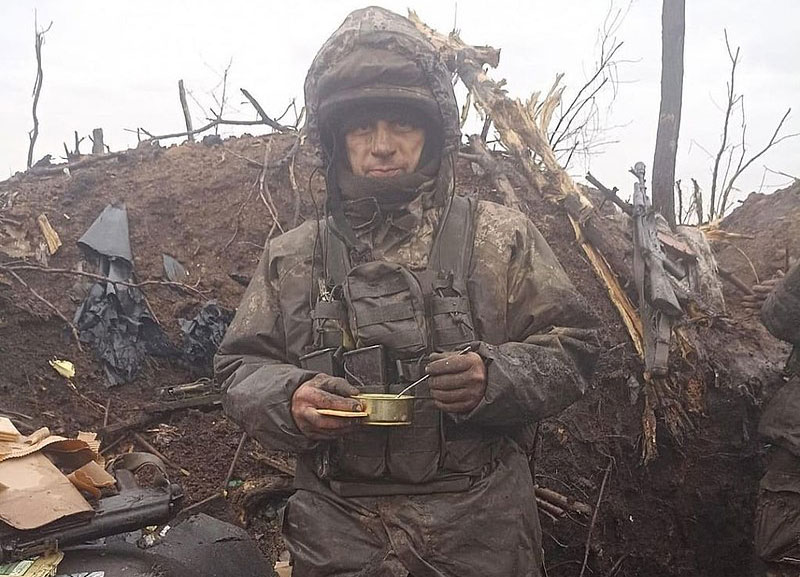A Developing Crisis in the Ukraine War

Ukrainian soldier at Bakhmut
Bakhmut is a city of about 71,000 in Donetsk oblast (state), about 40 miles north of the city of Donetsk, capital of the seceded Donetsk Republic, with a population of over 900,000. The population of the Donetsk oblast in 2013 was 4.4 million, Ukraine’s most populous region and about 10 percent of the total population of Ukraine. Donetsk oblast is also the most mineral-rich and industrial region of Ukraine. The Donetsk oblast is over 90 percent Russian-speaking and judging from voting records (2010), Russian ethnic and cultural identity is also over 90 percent. Nine oblasts in southern and eastern Ukraine voted 60 to 90 percent for a pro-Russian candidate for President, Viktor Yanukovych, in 2010. Yanukovych was a former Governor of Donetsk oblast. When Yanukovych was overthrown by a violent U.S. State Department, CIA, and British MI6 backed coup in February 2014, Donetsk, Lugansk, to its east, and Crimea, to its south, petitioned the Russian Federation to receive them as oblasts of the Russian Federation.
Crimea was immediately accepted because of its history and critical naval and military value, but Donetsk and Lugansk were encouraged to become independent republics within Ukraine, because their huge pro-Russian voting bloc was important in preventing Ukraine from becoming an anti-Russian satellite of NATO and the European Union. Lugansk oblast has a population of 2.1 million, which voted 89 percent pro-Russian in 2010. Crimea has a population of 2.4 million and voted 78 percent pro-Russian in the same election. The Crimean population is only about 15 percent Ukrainian and has never been more than 25 percent Ukrainian. The independent status of Donetsk and Lugansk were part of the Minsk II peace agreement agreed to by Ukraine in September 2015 but was never implemented as promised. Why?
From 1924 to 2016, Bakhmut was called by its Russian name, Artemivsk. In 2016, under a naming reform law, the Ukrainian Parliament changed its name to Bakhmut, a former Turkish name. This is a good example of the anti-Russian cultural engineering that set off and kept the Donbas War going. This name-changing and monument-destroying social-tyranny ideology should be familiar to many Americans.
Because Bakhmut has been a major supply depot for the Ukrainian Army’s siege of the city of Donetsk, Bakhmut has been under heavy attack by Russian forces since early August. Most of the civilian population has fled. The mayor recently reported that less than 22,000 residents remained there.
Until recently, the number of Ukrainian troops in Bakhmut and nearby areas was reported to be about 30,000. As usual for the Russians, the siege of Bakhmut has been largely an artillery battle. Although the Russian forces numbered fewer than the Ukrainians at first, their artillery forces far outnumber and are better supplied than the Ukrainian artillery. The range and accuracy of most Russian and Ukrainian artillery are about the same. However, with more artillery and more ammunition, Russian shelling is generally at least five times the Ukrainian return fire, and Ukrainian casualties have usually been disproportionately heavy. Up until recently, the predominant portion of Russian forces were from the Wagner PMC units. These PMC (private military companies) units are something like a Russian Foreign Legion, although they are mostly Russian mercenaries, many of them are recruited from Russian prisons on the promise of erasing prison sentences and restoring civil status. Besides these are Donetsk militia and regular Russian troops, which are steadily increasing. There are also special units of Cossacks and Chechens. In addition, many experienced Russian troops are being re-deployed there from the Kherson area.
Several reporters and a senior U.S. Defense Department official have called the Battle for Bakhmut the bloodiest of the 21st Century and comparable to the devastation of artillery battles of World War I. Holly Ellyatt compared Bakhmut and its destruction, mud, and death to the Battle of Verdun between the Germans and French in 1916, which has become a symbol of the horrors and futility of war.
Russian reports have indicated that Bakhmut is now nearly surrounded by freshly arriving Russian infantry and artillery forces. Ukraine’s President Zelensky admits that the situation is desperate. Greek journalistic sources speculate that another 30,000 Ukrainian troops are being pulled from northern Zaporizhia and western Kherson to rescue Bakhmut.
According to Col. (ret) Douglas MacGregor, writing on November 29, in The American Conservative, the Russian Federation is prepared for a major offensive against Ukraine with 540,000 combat forces ready in Southern Ukraine, Western Russia, and Belarus. This undoubtedly includes the Wagner PMC units whose numbers have grown from 8,000 to 40,000. The munitions include 1,000 rocket artillery systems, thousands of ballistic missiles, cruise missiles, and drones. In addition to 1,500 tanks and another 3,500 combat vehicles, there are hundreds of combat aircraft and helicopters, including bombers equipped with multiple precision air to ground missiles. This could easily triple or quadruple Russian rocket, artillery, and air attack capabilities. Russian rocket attacks have already destroyed much of Ukraine’s anti-missile capability.
The average high temperature in Donetsk city in December is 32 degrees F, so frozen ground will replace the fall mud. But this is perfect for the Russian style of winter warfare using tanks, armored vehicles, and self-propelled artillery.
Recently, the Russians have been destroying the Ukrainian electrical system with up to 90 rockets launched per day. According to Vitali Klitschko, Mayor of Kyiv, (population 3.0 million), two-thirds of the capital’s population currently have no electricity, heat, or potable water. He has suggested that much of Kyiv’s population may have to be evacuated unless the situation improves. Some speculate that the major Russian offensive now in its final stages of preparation could result in two to eight million more refugees crowding into Poland, Germany, Rumania, and other nearby NATO states.
The mainstream media will be slow to mention the siege of Bakhmut, but a crisis is developing.
German politician and European Union Commission President Ursula von der Leyen caused a major NATO controversy recently when she publicly mentioned that 100,000 Ukrainian “officers” (she meant soldiers) had been killed in the war (KIA). Her speech was immediately walked back and edited, claiming she meant 100,000 casualties and not killed. Casualties include killed, missing, wounded, and captured. Estimates of wounded can vary by definition from requiring medical treatment to permanent disability, so they are not easily comparable. Depending on the type of warfare and disability definition, the wounded often run two to five times KIA. A 100,000 KIA for Ukrainian forces would raise an alarm bell for the sustainability of Ukrainian combat operations. Yet military consultant Col. Douglas MacGregor has estimated Ukrainian KIA at over 100,000.
There are numerous wildly varying estimates and propaganda about military casualties in the war. My combined estimate of many sources suggests that Ukrainian killed-in-action (KIA) had risen to about 82,000 by November 15 and continue at about 9,000 per month, which is a little lower than MacGregor’s estimates. These high casualties are largely because of the imbalance of artillery assets and munitions. The combined Russian, Donbas militias, Wagner PMC, Chechen, and other forces probably total less than 20,000 KIA and currently continue at not more than 1,000 to 1,500 KIA per month. The question is how much longer can the Ukrainian Army sustain such disproportionate losses?
The Ukrainian Armed Forces have four major shortages: artillery systems, artillery munitions, anti-rocket/anti-aircraft systems, and combat ready Ukrainian soldiers. Russian rocket and air attacks are already devastating electrical power systems critical to both civilian and military Ukrainian needs.
Western media propaganda constantly glorifies the Ukrainian and demonizes the Russian perspectives of the present NATO-Russia conflict. It also underestimates Russian capabilities and logistical advantages. Thus the American public and especially their Congressional representatives need to pay more attention and do more critical analysis to understand what is really going on in in Ukraine, NATO, and Washington. Truth comes before wisdom. We are on dangerous military, economic, and foreign policy ground. Joe Biden, as Obama’s Vice President, helped foster the regime change that started the Donbas War in 2014, and with his radical Administration continues to perpetuate the same dangerous foreign policy follies today.
The siege of Bakhmut has become a major Ukrainian War crisis.
-------------------------
Click HERE to see a Russian language map of Ukraine. Bakhmut is Artemivsk on this map. Might be handy for finding towns, etc.









 Mike Scruggs is the author of two books: The Un-Civil War: Shattering the Historical Myths; and Lessons from the Vietnam War: Truths the Media Never Told You, and over 600 articles on military history, national security, intelligent design, genealogical genetics, immigration, current political affairs, Islam, and the Middle East.
Mike Scruggs is the author of two books: The Un-Civil War: Shattering the Historical Myths; and Lessons from the Vietnam War: Truths the Media Never Told You, and over 600 articles on military history, national security, intelligent design, genealogical genetics, immigration, current political affairs, Islam, and the Middle East. 


